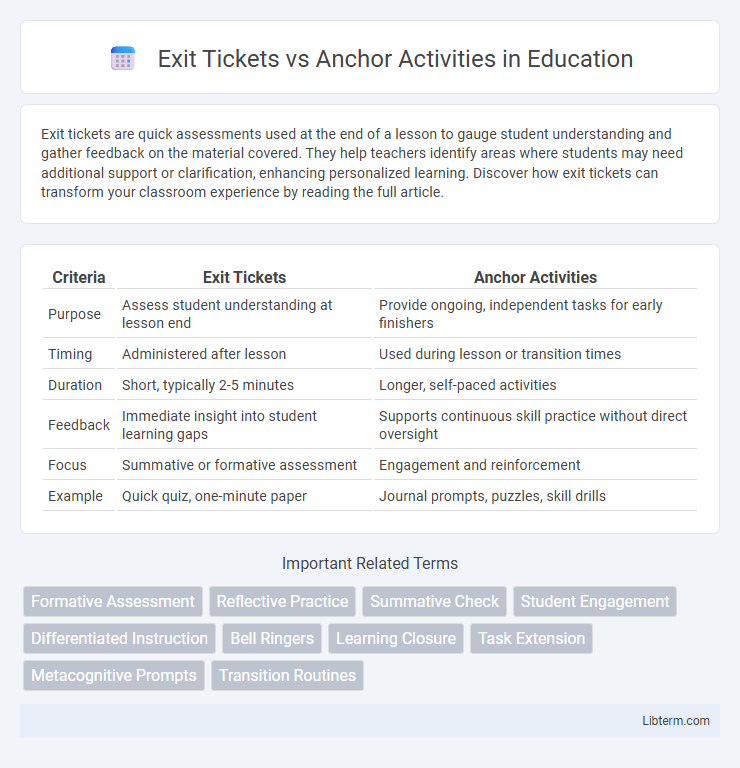Exit tickets are quick assessments used at the end of a lesson to gauge student understanding and gather feedback on the material covered. They help teachers identify areas where students may need additional support or clarification, enhancing personalized learning. Discover how exit tickets can transform your classroom experience by reading the full article.
Table of Comparison
| Criteria | Exit Tickets | Anchor Activities |
|---|---|---|
| Purpose | Assess student understanding at lesson end | Provide ongoing, independent tasks for early finishers |
| Timing | Administered after lesson | Used during lesson or transition times |
| Duration | Short, typically 2-5 minutes | Longer, self-paced activities |
| Feedback | Immediate insight into student learning gaps | Supports continuous skill practice without direct oversight |
| Focus | Summative or formative assessment | Engagement and reinforcement |
| Example | Quick quiz, one-minute paper | Journal prompts, puzzles, skill drills |
Introduction to Exit Tickets and Anchor Activities
Exit tickets are brief assessment tools used at the end of a lesson to gauge student understanding and inform future instruction. Anchor activities refer to meaningful tasks designed to engage students independently during transitions or when immediate teacher support is unavailable. These strategies enhance classroom management and formative assessment by providing insights into student learning and maintaining productive engagement.
Purpose and Benefits of Exit Tickets
Exit tickets serve as quick formative assessments that allow teachers to gauge student understanding at the end of a lesson, providing immediate feedback on learning outcomes. They help identify areas of confusion, inform future instruction, and promote student reflection on the material covered. Exit tickets enhance classroom engagement by encouraging students to summarize key concepts and articulate their learning progress.
Purpose and Benefits of Anchor Activities
Anchor activities serve as purposeful, independent tasks that engage students during transitional periods, ensuring continuous learning and minimizing downtime. These activities promote student autonomy, reinforce skills, and provide teachers with informal assessment opportunities without disrupting instructional flow. The benefits include enhanced classroom management, increased student responsibility, and sustained academic momentum throughout the school day.
Key Differences Between Exit Tickets and Anchor Activities
Exit tickets are brief assessments completed at the end of a lesson to gauge student understanding and inform immediate instructional adjustments, whereas anchor activities are ongoing tasks designed to engage students productively when they finish work early or need to wait. Exit tickets typically last 5 minutes and provide quick formative feedback, while anchor activities support extended independent learning and classroom management throughout a lesson. The key difference lies in their timing and purpose: exit tickets assess mastery after instruction, whereas anchor activities maintain student engagement during transitional or downtime periods.
When to Use Exit Tickets in the Classroom
Exit Tickets are most effective at the end of a lesson to quickly assess student understanding and identify areas needing further clarification. They provide immediate feedback on the day's objectives, helping teachers adjust subsequent instruction and support. Using Exit Tickets regularly enhances formative assessment by capturing students' reflections and mastery in a concise format.
Ideal Scenarios for Anchor Activities
Anchor activities are ideal in classrooms where students require continuous engagement while the teacher provides personalized support to small groups. These tasks are designed to be self-directed, allowing learners to work independently at their own pace without frequent intervention. Perfect for differentiated instruction, anchor activities foster autonomy and maintain productivity during transitional periods or when the teacher needs time for focused instruction.
Examples of Effective Exit Tickets
Effective exit tickets include quick reflection questions like "What was the most important concept you learned today?" or "What questions do you still have?" These prompts help teachers assess student understanding and guide future instruction, contrasting with anchor activities that provide ongoing, independent tasks during lessons. Exit tickets are concise, targeted tools that capture student feedback at the lesson's end, enabling immediate adjustment to instructional strategies.
Creative Anchor Activity Ideas
Creative anchor activities engage students in meaningful tasks that promote deeper understanding while allowing teachers to manage classroom flow effectively. Examples include multimedia response journals, thematic art projects related to lesson content, or collaborative concept mapping that encourages critical thinking and interaction. These activities provide ongoing learning opportunities, contrasting with Exit Tickets, which primarily serve as quick, formative assessments to gauge student comprehension at the end of a lesson.
Impact on Student Engagement and Assessment
Exit Tickets provide immediate formative assessment by prompting students to reflect on lesson content, boosting engagement through active participation and self-assessment. Anchor Activities maintain continuous engagement during transitional periods by offering meaningful, independent tasks that reinforce skills without direct teacher input. Together, these strategies optimize classroom dynamics by balancing real-time assessment with sustained student involvement.
Choosing the Right Strategy for Your Classroom
Exit tickets provide immediate feedback on student understanding, allowing teachers to assess learning outcomes quickly and tailor subsequent lessons effectively. Anchor activities offer ongoing, independent tasks that keep students engaged while the teacher works with small groups, promoting differentiated instruction and classroom management. Selecting between exit tickets and anchor activities depends on classroom goals, student needs, and the desired balance between assessment and active learning.
Exit Tickets Infographic

 libterm.com
libterm.com